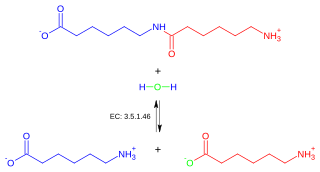| riboflavinase | |||||||||
|---|---|---|---|---|---|---|---|---|---|
| Identifiers | |||||||||
| EC no. | 3.5.99.1 | ||||||||
| CAS no. | 9024-79-7 | ||||||||
| Databases | |||||||||
| IntEnz | IntEnz view | ||||||||
| BRENDA | BRENDA entry | ||||||||
| ExPASy | NiceZyme view | ||||||||
| KEGG | KEGG entry | ||||||||
| MetaCyc | metabolic pathway | ||||||||
| PRIAM | profile | ||||||||
| PDB structures | RCSB PDB PDBe PDBsum | ||||||||
| Gene Ontology | AmiGO / QuickGO | ||||||||
| |||||||||
In enzymology, a riboflavinase (EC 3.5.99.1) is an enzyme that catalyzes the chemical reaction
- riboflavin + H2O ribitol + lumichrome
Thus, the two substrates of this enzyme are riboflavin and H2O, whereas its two products are ribitol and lumichrome.
This enzyme belongs to the family of hydrolases, those acting on carbon-nitrogen bonds other than peptide bonds, specifically in compounds that have not been otherwise categorized within EC number 3.5. The systematic name of this enzyme class is riboflavin hydrolase. This enzyme participates in riboflavin metabolism.

